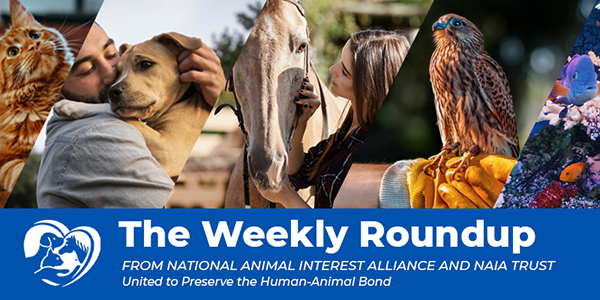
Inside This Issue:
- Election 2024: Colorado Rejects Animal Rights Extremism
- Sorry, Arachnophobes: UK Zoo Reintroduces Thousands of Giant Spiders Into the Wild
- Maine Dogs Learn to Sniff Out Invasive Species
- Elephants Succumb to Undetectable Toxin After Crop Raid
- Animals That Eat Poop: They're Not Just Trying to Gross You Out
Election 2024: Colorado Rejects Animal Rights Extremism

Rural and urban voters have very different opinions when it comes to hunting mountain lions.
Good news: three high-profile animal rights-based measures were defeated in Colorado on election day: Proposition 127, and two ordinances in Denver.
Proposition 127 would have banned the hunting of mountain lions and bobcats. Supporters of this proposition used misleading language when promoting it, referring to it as a ban of “trophy hunting,” despite trophy hunting already being illegal in Colorado (under current law, you must consume the edible parts of a lion that you hunt). As with the state’s controversial wolf reintroduction of 2020, Proposition 127 cast a glaring light on the state's urban-rural divide. Support for the proposition was largely confined to urban areas, while opposition was strong in rural areas. Critics use the term "ballot box biology" when referring to ballot measures like Proposition 127, where emotional appeals override scientific expertise – this is convenient and accurate shorthand for phenomena we are all too familiar with.
Moving on to Denver, Ordinance 308 would have banned fur products, and its broad language* could have gone so far as to prohibit items like fly-fishing lures and cowboy hats. Ordinance 309 targeted Denver's only slaughterhouse, Superior Farms, which processes as many as 20% of the country’s lambs. Closing this facility would have devastated Colorado's sheep industry and cost the state $861 million and 2,787 jobs. Despite labor union opposition, animal rights groups poured money into pushing this national campaign to ban slaughterhouses. Fortunately, common sense prevailed and these measures were soundly defeated.
Colorado ranchers face an ongoing battle against extremism fueled by the governor and urban voters. While these ballot measures were defeated, the fight is far from over. It's essential for rural communities, wildlife professionals, and those who prioritize science-based policies to unite and remain vigilant.
* At this point, we have to accept that when it comes to animal rights legislation, overly broad language is a feature, rather than a bug.
Sorry, Arachnophobes: UK Zoo Reintroduces Thousands of Giant Spiders Into the Wild

Just hanging out, waiting for a meal to hop, drop, or swim by.
England’s Chester Zoo is enjoying a well-deserved celebration for its efforts to help repopulate one of the UK’s rarest spiders – the massive fen raft spider. Partnering with the Royal Society for the Protection of Birds, the two organizations proudly reported that their efforts, which began in 2011, have resulted in 10,000 breeding females in the wild, and that this year was their best mating season on record. Impressive and fast work, especially considering how rare these spiders were 20 years ago.
About the size of your palm, the fen raft spider’s decline in numbers began with the destruction of its wetland habitats where they play an important role in the food chain. The spiders hunt anything from water skeeters and smaller spiders to minnows and tadpoles, while also serving as a great meal for wetland birds.
Now, we’ve already mentioned the size of this spider twice, and also that it is an excellent hunter, but don’t be intimidated! Despite being large and fast enough to dine on a fish (albeit, a small fish!), it would rather run away from you. And if one is pushed to the point where it actually feels a need to bite you, let’s be honest: you probably deserved it.
Source: UK zoo celebrates release of rare spiders that can grow to size of human hand
Maine Dogs Learn to Sniff Out Invasive Species

The Canine Information Highway.
A dog’s sense of smell is, quite simply, powerful beyond our comprehension. With just a sniff, dogs can suss a dizzying, highly detailed amount of information about the world around them – especially when it comes to other dogs! Being our best friends and working partners, it’s no surprise that we’ve taken note, and found useful human-centric ways of utilizing this fantastic sense, too. And dogs are always up for the task, whether that job is sniffing out cadavers, contraband, or even cancer.
Now, dog noses are working on a different problem: invasive species. Two universities and an animal non-profit began a study last February to test whether dogs could sniff out the dreaded spotted lanternfly – an invasive and voracious planthopper with no native predators that now has a foothold in at least 16 states. The results are already extremely promising, and today, 15 dogs know to alert their walkers if they come across the scent of spotted lanternfly eggs. Such quick results speak to the skill of the trainers and researchers. Moreso, it highlights the amazing noses and wonderful brains of the dogs. Well done!
Already there is talk about branching out into other invasive species. And if this becomes normalized. what a way to multi-purpose your dog walks! You get a little exercise, your dog gets some much-needed mental stimulation and movement, and who knows – you may just end up saving your county’s soybean crop along the way.
Source: Research shows dogs can help detect invasive insect species in Maine
Elephants Succumb to Undetectable Toxin After Crop Raid

It is believed that heavy rains led to the toxic fungal growth that killed the elephants.
Almost all the members of a small elephant herd in central India perished last week, leaving forest officials bewildered and worried for the health and safety of other wild elephants in the area.
The herd lived in Bandhavgarh National Park in Madhya Pradesh where they came upon kodo millet fields, a crop farmed in that region due to its favorable arid climate for the plant. After heavy rains, it is believed that the millet grew fungus that contained a neurotoxin called cyclopiazonic acid (CPA). CPA can cause neurological dysfunction as well as liver, kidney, and spleen necrosis and gastrointestinal issues. This is difficult for a hind-gut fermenter like elephants to recover from.
After the tragic incident, officials didn’t want to take any chances, so they mowed down the surrounding areas with kodo millet crops to protect other grazing wildlife. Ecologists note that elephants have a keen sense of smell and taste, but that CPA is odorless and tasteless. After the investigation by officials, it was found that there was no foul play and that this was just an extremely unfortunate accident. While rare, this is still classified as a human-elephant conflict event that resulted in the deaths of ten endangered Asian elephants.
Source: Alarm over death of 10 elephants in India national park
Animals That Eat Poop: They're Not Just Trying to Gross You Out

They are probably watching you walk your dog.
For many of us, just the smell of poop is enough to turn our stomachs. Yet, there are lots of animals who not only enjoy the rank stench of feces, but even – gack! – love to feast on it. This behavior, called coprophagy, is actually very common in the animal kingdom, and all vertebrates have representative species that engage in it. Some of these animals might even be considered connoisseurs: one famous carrion eater, for example, shows a preference for the type of feces it eats.
Since we consider feces to be a form of biohazardous waste (not without reason), this behavior might seem more than uncouth. It might seem unhealthy or even dangerous for the animals that engage in it. You may ask yourself “What’s wrong with these weirdos?!” when you see it. But in most cases, there’s nothing wrong – nature is actually working as intended.
In species like rabbits, coprophagy is a matter of keeping their digestive system moving and not leaving anything behind. They miss out on a lot of their food’s nutrients on the first go ‘round, so they eat their own pellets again to maximize the nutritional benefit. You might call it gross, but the rabbit is simply being efficient! Species like foxes eat the droppings of other animals during rough times to meet their caloric needs. According to the National Geographic article we’ve linked to here, foxes are particularly drawn to your dog’s poop in colder months, because dog feces offers up roughly the same calories as cooked chickpeas. We’re not sure if this is a compliment to dogs or an insult to chickpeas, but the Dry Pea and Lentil Council probably isn’t too happy with the comparison. Meanwhile, there are lots of fish that engage in coprophagy as a means of securing much-needed micronutrients, while numerous birds do it to diversify and “jumpstart” their gut flora – hey, we all know a healthy microbiome is a happy microbiome!
Source: Why do animals eat their own poop—and other animals’ too?
Also in the News...
★ 43 monkeys on the loose after escaping South Carolina research facility (Animal Research; Animal Recovery)
★ Evolutionary anthropologist presents hypothesis about why humans are dominating the world over other animals (Open-Ended Culture)
★ SeaWorld San Antonio names two new aquatic animals (Adorable Beluga and Dolphin Calves)
★ Hornets can hold their alcohol like no other animal on Earth (Animals & Alcohol I: S-Tier Tolerance)
★ Animals Might Be Drinking More Than We Thought (Animals & Alcohol II: Boozy Socialization?)
★ What do horror movies and marmots have in common? Screams (Screams Unnerve Throughout the Animal Kingdom – But Why?)
★ DeKalb County Animal Shelter’s population reaches over 600 dogs (Shelter Crowding; 475 over Capacity)
★ A Texas Photographer Captures Stunning Portraits of Farm Animals (Gorgeous Photographic Lists; Huacaya Alpaca Pose)
Click here to see what is happening legislatively

